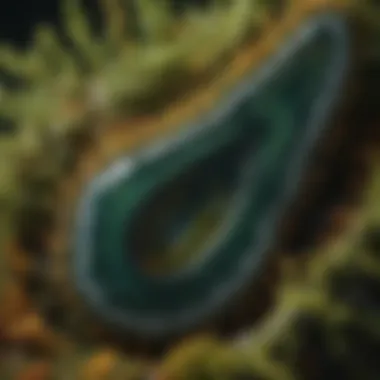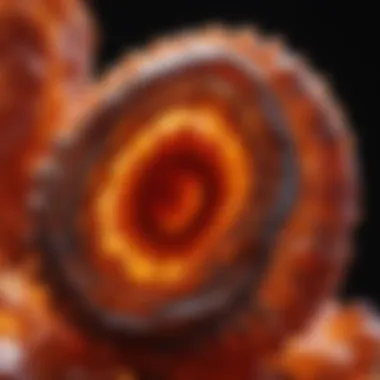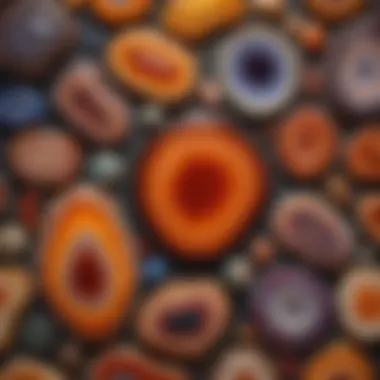Unveiling the Diverse World of Agate: An In-Depth Guide to Different Varieties of Agate


Overview of Gemstones and Minerals
Agate, a mesmerizing gemstone revered for its unique patterns and colors, holds a significant place in the realm of gemstones and minerals. The history of gemstone and mineral use traces back centuries, where these natural beauties adorned kings and queens, symbolizing power and prestige. Today, agate continues to captivate gemstone enthusiasts, collectors, and jewelry designers worldwide, blending cultural significance with sheer aesthetic allure. Its presence in various cultures and societies adds layers of meaning to this exquisite gem.
Gemstone Formation and Properties
Exploring the formation process of agate unveils a fascinating journey of mineral crystallization over millions of years. This intricate process involves the gradual deposition of silica within cavities in rocks, resulting in the unique banding and colors that define agate. Properties such as hardness, luster, and color classification further distinguish agate from other gemstones, highlighting its exceptional beauty and durability in jewelry and decorative pieces.
Types of Gemstones
Within the spectrum of gemstones, agate stands out as a semi-precious gemstone that bridges the gap between the common and the rare. Its variations, including banded, moss, and fire agate, showcase the breadth of possibilities within this mesmerizing category. Unlike precious gemstones like diamonds or rubies, agate offers an affordable yet alluring option for those seeking unique and expressive jewelry pieces that reflect their individuality.
Identifying and Evaluating Gemstones
Unraveling the mysteries of gemstone value involves understanding key factors that influence price and desirability. Techniques for gemstone identification, such as spectroscopy and magnification, play a crucial role in determining authenticity and quality. Evaluating gemstone quality requires a keen eye for clarity, color intensity, and any visible inclusions, ensuring a precise assessment of a gemstone's worth within the market.
Caring for Gemstones
Proper care and maintenance are essential to preserve the beauty and shine of agate and other gemstones. Cleaning methods tailored to specific gem types, such as gentle brushing for delicate surfaces and avoiding harsh chemicals, help extend the longevity of these precious stones. By following expert preservation tips and storing gemstones in appropriate conditions, enthusiasts can enjoy their stunning agate pieces for generations to come.
Introduction to Agate
Agate, a mesmerizing gemstone revered for its intricate patterns and vibrant colors, holds a significant place in the world of mineralogy and jewelry craftsmanship. Its exquisite beauty and diverse formations make it a captivating subject for enthusiasts and collectors alike. In this comprehensive guide to different types of agate, we delve deep into the essence of this natural wonder, unraveling its mysteries and unveiling its unique characteristics. From the enthralling banded agate to the delicate moss agate and the fiery allure of fire agate, each variety within the agate family boasts distinct features that set them apart in the realm of gemstones.
Understanding Agate Formation


The Process of Agate Formation
Embarking on a journey through the process of agate formation unveils a fascinating narrative of geological artistry. Agate originates from the deposition of silica in concentric layers within cavities of volcanic rocks or ancient lava flows. This meticulous process spanning thousands of years results in the mesmerizing banding and vibrant colors that adorn agate specimens. The intricate interplay of pressure, heat, and mineral content influences the unique internal structures and color patterns found in agate, making each piece a work of natural artistry.
Geological Factors Influencing Agate
Unraveling the geological factors that shape agate elucidates the dynamic forces at play deep within the Earth's crust. Regions rich in silica deposits and volcanic activity create optimal conditions for agate formation. The slow crystallization process combined with the presence of trace elements imparts diverse colors and patterns to agate. Understanding these geological intricacies offers profound insights into the formation and variability of agate specimens, enhancing appreciation for their aesthetic and scientific value.
Formation of Agate Bands
The formation of agate bands showcases nature's artistic prowess at its finest. As silica-laden water percolates through rock cavities, it deposits successive layers of minerals, creating the characteristic banding in agate. The alternating layers of chalcedony and microcrystalline quartz give rise to captivating patterns and hues, reflecting the geological history of the environment where the agate formed. Studying the formation of agate bands unveils the intricate processes shaping these exquisite gemstones and underscores the significance of geological context in determining their visual appeal.
Historical Significance of Agate
Agate in Ancient Civilizations
Across ancient civilizations, agate held profound symbolism and functional significance. Used for talismans, amulets, and ornamental purposes, agate was revered for its perceived protective and healing properties. The intricate banding and vibrant colors of agate captivated ancient peoples, who attributed mystical qualities to this gemstone. Delving into the historical use of agate unveils a fascinating tapestry of cultural beliefs and artistic adornment, enriching our understanding of its enduring appeal.
Symbolism and Cultural Uses of Agate
Beyond its ornamental value, agate's symbolism permeates various cultures worldwide. revered for promoting harmony and balance, agate is associated with stability and strength, making it a cherished talisman for those seeking equilibrium. From ancient rituals to modern spiritual practices, agate continues to be treasured for its metaphysical attributes. Exploring the symbolism and cultural significance of agate sheds light on the enduring allure of this gemstone and its relevance in diverse societal contexts.
Types of Agate
In the vast world of agate, understanding the different types holds significant importance. Each type of agate comes with its unique characteristics and formations, making them a subject of interest for gemstone enthusiasts and collectors. The exploration of banded agate, moss agate, fire agate, blue lace agate, crazy lace agate, dendritic agate, laguna agate, and turritella agate offers a diverse range of appearances and properties. The variations in patterns, colors, and uses make each type distinctive, contributing to the allure of agate as a gemstone.
Banded Agate


Characteristics of Banded Agate
Banded agate showcases distinctive banding patterns that set it apart from other types. The characteristic layers of colors and textures in banded agate provide a visually appealing aspect. This unique feature contributes to banded agate's popularity in jewelry and decorative pieces, adding depth and character. Despite its aesthetic advantages, the banding patterns can vary in intensity and consistency, presenting challenges in certain design contexts.
Color Variations in Banded Agate
The color variations in banded agate range from subtle earth tones to vibrant hues, offering a wide spectrum of choices for artisans and collectors. The diverse palette of colors allows for versatile applications in jewelry making and ornamentation. However, the natural variations in colors may pose challenges in achieving consistency in pieces that require uniformity.
Popular Sources of Banded Agate
Banded agate can be sourced from various locations globally, with notable deposits in regions known for producing high-quality specimens. The popularity of banded agate among lapidaries and collectors stems from its widespread availability and diverse color schemes. However, differences in the geological makeup of deposits can influence the quality and characteristics of banded agate, requiring discerning selection for desired outcomes.
Moss Agate
Distinctive Features of Moss Agate
Moss agate is renowned for its unique inclusion patterns that resemble moss or foliage, creating a picturesque effect within the stone. The organic patterns within moss agate add a natural charm and individuality to each piece, making it a favored choice for nature-inspired designs. Despite its aesthetic appeal, the intricate formations of moss agate can vary, leading to challenges in matching specific patterns for custom creations.
Origin and Formation of Moss Agate
The origin of moss agate traces back to geological processes involving silica-rich fluids and mineral deposition over time. The formation of moss agate occurs in layers, capturing organic inclusions that give rise to its distinct appearance. While the formation process contributes to the beauty of moss agate, the intricate structures can present complexities in cutting and shaping the stone for jewelry and decorative purposes.
Usage in Jewelry and Decor
Moss agate's natural motifs and soothing colors make it a popular choice for jewelry and decorative items seeking a connection to nature. The versatile usage of moss agate in earrings, pendants, and ornamental pieces reflects its elegant appeal and calming aesthetic. However, the delicate nature of moss agate requires careful handling to preserve its intricate patterns and prevent damage during crafting processes.


Fire Agate
Fire Agate's Play of Color
Fire agate displays a mesmerizing play of iridescent colors, reminiscent of flickering flames within the stone. This optical phenomenon adds a dynamic dimension to fire agate, captivating viewers with its fiery hues. The vivid colors and patterns in fire agate make it a sought-after gemstone for unique and striking jewelry pieces. Despite its visual appeal, the play of color in fire agate can vary in intensity, influencing its overall value and desirability.
Geological Characteristics of Fire Agate
The geological formation of fire agate involves specific conditions of heat and pressure, resulting in its distinctive color play. The interplay of light and mineral structures within the stone creates the fiery iridescence that sets fire agate apart from other varieties. While the geological characteristics contribute to the beauty of fire agate, variations in these conditions can impact the consistency and quality of the color display.
Significance in Metaphysical Practices
In metaphysical practices, fire agate is believed to possess energetic properties that enhance courage and creativity. The vibrant hues and dynamic patterns in fire agate symbolize passion and vitality, making it a favored crystal for spiritual healing and energy work. However, individual interpretations of fire agate's metaphysical significance may vary, influencing its perceived benefits and applications.
Rare and Exotic Agate Varietie
he section on Rare and Exotic Agate Varieties delves into the exceptional and scarce variants of agate, bringing attention to their distinctive allure and rarity within the gemstone world. These specialized varieties hold a paramount significance in the jewelry and collector's market, attracting enthusiasts due to their uniqueness and scarcity factor. The discussion will highlight the exquisite and rare nature of these agate types, emphasizing their importance in showcasing the breadth and depth of agate diversity, captivating both seasoned collectors and newcomers to the gemstone realm.Invalid Stunning Patterns and Stunning Bands make these agates highly sought-after by passionate collectors who value exclusivity and uncommon beauty.Most exquisite Geographical Occurrences and Geological Origins add to the irreplaceable appeal of these rare agates.The focus on Rare and Exotic Agate Varieties in this article aims to shed light on the hidden treasures within the world of agate, offering insights into the remarkable characteristics and value of these gems.###H me Agate## Fea y Inclusions of Plume AgateDiscussing Feathery Inclusions of Plume Agate unveils a mesmerizing aspect of these stones, emphasizing the delicate and intricate patterns that resemble feathers and give these agates their distinctive name. The unique feather-like formations within Plume Agate contribute to its elegance and sought-after aesthetic, making it a popular choice among jewelry designers and collectors alike. The soft and graceful appearance of Feathery Inclusions of Plume Agate adds a touch of sophistication to any piece of jewelry, enhancing its overall appeal and charisma. Despite Occasionally Addapting Visible Cracks, Feathery Inclusions of Plume Agate remain a favored option for those seeking refined and distinctive gemstones in their collection.### Color rasts in Plume AgateExploring Color Contrasts in Plume Agate reveals a captivating interplay of hues and tones within these stones, creating striking visual contrasts that mesmerize the beholder. The vivid and varied colors present in Color Contrasts in Plume Agate enhance its beauty and make it a versatile choice for crafting exquisite jewelry pieces. The distinct color patterns and contrasts in Plume Agate allow for endless creative possibilities, making each piece unique and alluring in its own right. Despite Infrequent Color Fading, Color Contrasts in Plume Agate continue to captivate gemstone enthusiasts and collectors with their mesmerizing beauty.### Collector voritesThe section focusing on Collectors' Favorites sheds light on the most coveted and cherished variations of agate, highlighting the exceptional qualities and features that make these agates highly sought after by collectors worldwide. The selection of a color palette for Collectors' Favorites is significantly influenced by the market trends and popular preferences among gemstone enthusiasts. These particular agates hold a special place in the hearts of collectors due to their exceptional beauty, rarity, and historical significance. Despite the Occasionally Appearing Visible Inclusions and Flaws, Collectors' Favorites remain prized possessions among collectors and jewelry connoisseurs, adding a touch of prestige and exclusivity to any collection.## Tube Agate## mation of Tubu Structures in Tube AgateExploring the Formation of Tubular Structures in Tube Agate unveils a fascinating aspect of these gemstones, focusing on the unique geological processes that create the distinctive tube-like patterns within the agate. The formation of these tubular structures lends Tube Agate its distinctive appearance and sets it apart from other agate varieties. Horizontally occasional barriers Large and tiny tubes are formed Fulgidly that reodorize speculators and stone enthusiasts.Unique and aesthetically pleasing, the Formation of Tubular Structures in Tube Agate adds a touch of intricacy and sophistication to jewelry pieces, making them highly desirable amongst collectors and designers alike.## Color Patterns in Tu gateDiving into the Color Patterns of Tube Agate reveals a captivating array of colors and designs that are characteristic of this unique gemstone. Tube Agate showcases a variety of color combinations and patterns, ranging ### Geological Occurrences eological Occurrences surrounding Tube Agate offer an intriguing glimpse into the natural phenomena that shape the formation of these gemstones. The specific geological conditions required for the development of Tube Agate create an environment where unique colors, patterns, and structures can flourish, making each piece a work of art crafted by nature. Despite periodic seismic shifts and disruptions Geology Chronic Cases, the Geological Occurrences associated with Tube Agate continue to fascinate geology enthusiasts and collectors with their geological complexity and visual appeal.
Conclusion
Appreciating the Diversity of Agate
Versatility in Agate's Uses
Exploring the versatility in agate's uses sheds light on its multifaceted nature within the realm of gemstones. Agate's versatile characteristics, such as its wide array of colors, patterns, and translucency, make it a sought-after choice for jewelry designers, collectors, and energy practitioners alike. The ability of agate to be carved, polished, and shaped into various forms enhances its versatility, allowing for diverse creative expressions and unique aesthetic creations. Whether used in statement necklaces, healing bracelets, or ornate decor pieces, the adaptability of agate in both intricate designs and simplistic settings underscores its enduring popularity.
Collecting and Caring for Agate
Considering the aspects associated with collecting and caring for agate is crucial for preserving its natural beauty and properties. Collectors engage in meticulous searches for agate specimens with distinct characteristics such as vibrant colors, intricate banding, and unique inclusions like dendrites or plumes. Proper care practices, including gentle cleaning with mild soap and water, storing away from sunlight to prevent color fading, and avoiding exposure to harsh chemicals, ensure the longevity of agate's beauty. Understanding the geology behind agate formation also enriches collector's experiences, appreciating the historical and natural contexts in which these gemstones are found.
Continued Fascination with Agate
The enduring fascination with agate stems from its timeless appeal and enigmatic charm. As collectors and enthusiasts delve deeper into the diverse world of agate, each new specimen or variety presents a unique mystery waiting to be unraveled. The intricate patterns, organic formations, and ancient origins of agate fuel a perpetual fascination among individuals keen on understanding the Earth's geological processes and the hidden wonders it holds. The continued exploration and appreciation for agate serve as a testament to humankind's enduring intrigue with the natural world, where each agate specimen carries a story as old and captivating as time itself.







